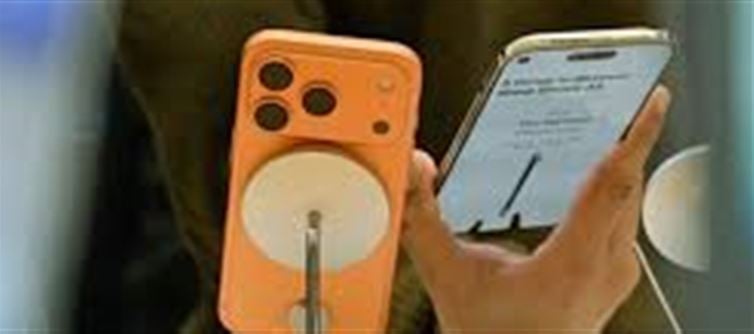
The launch of the iPhone 17 Pro has been met with excitement, but recent concerns about scratches on demo units in apple Stores have raised eyebrows. Many users and reviewers noticed visible surface marks, particularly around the MagSafe ring area. This led to online discussions about the phone's scratch resistance and the durability of its materials.
Here’s how Apple has responded to the controversy, clarifying some of the key issues raised by the public.
1. Scratch Marks on Demo Units: Demo Units Are Not Representative
Apple was quick to address the issue, emphasizing that the scratches observed on demo units were not indicative of the overall durability of the iphone 17 Pro. The company explained that demo units in retail stores are exposed to extensive handling by customers, which can contribute to surface marks that wouldn't occur with normal use.
· High Foot Traffic: Demo units are handled by numerous people each day, which increases the likelihood of surface abrasions.
· Exposure to Different Conditions: These phones are also placed under artificial lighting and exposed to different environmental conditions, potentially leading to wear and tear that isn't reflective of everyday use.
Apple reassured customers that their personal iphone 17 Pro devices would not experience the same issues if handled with care.
2. MagSafe Ring Area: Special Attention to Design Choices
One of the specific areas of concern was the MagSafe ring, which seemed to accumulate visible marks more easily than other parts of the device. apple explained that this was not a manufacturing flaw but rather a design choice made with aesthetic and functionality in mind.
· MagSafe Design: The MagSafe ring is crafted with magnetic alignment and a unique finish to ensure secure attachment of accessories. The material used may be more prone to visible markings during demo usage but does not affect the device's overall performance or durability.
· Functionality vs. Aesthetics: apple pointed out that the MagSafe ring is an integral part of the iPhone’s design, and while it may show some surface marks, it is still fully functional and doesn’t impact the device's core features.
3. Clarification on Scratch Resistance: Stronger Than Previous Models
Apple also took the opportunity to clarify that the iPhone 17 Pro features advanced materials that provide superior scratch resistance compared to earlier iphone models.
· Ceramic shield Glass: The iPhone 17 Pro continues to use the Ceramic Shield glass introduced in previous models, which is designed to be tougher and more resistant to scratches.
· Stainless Steel and Titanium Frame: The stainless steel (or titanium, for the Pro Max variant) frames are also designed to be more scratch-resistant than older models, offering better protection against everyday wear and tear.
However, apple also noted that while the materials are designed for improved durability, no phone is completely scratch-proof, and users should still use protective cases if they wish to avoid marks.
4. Apple’s Advice for Preventing Scratches
Apple provided some helpful tips for users who are concerned about scratches on their new iPhones:
· Use a Case: apple recommends using an official or third-party protective case to keep the device safe from scratches and accidental damage.
· Screen Protectors: To prevent surface marks on the display, using a screen protector is a good option, especially for users who want to maintain the pristine look of the phone.
· Gentle Handling: Regular cleaning of the iphone with a microfiber cloth can help reduce the appearance of fingerprints and surface marks. Avoid placing the phone on rough surfaces or with items like keys, coins, or sand.
5. customer Reactions: A Mixed Response
Despite Apple's clarifications, customer reactions have been mixed. Some users appreciate the transparency and the company’s proactive response, while others remain cautious about the phone’s durability in the long term.
· Positive Feedback: Many users believe Apple’s explanation makes sense, especially considering how demo units are handled.
· Concerns Persist: Some, however, still feel that surface marks shouldn't be as prominent, given the premium nature of the iphone 17 Pro.
6. Will This Affect iphone 17 Pro Sales?
While the scratch controversy has raised questions, the overall sales performance of the iphone 17 Pro is unlikely to be significantly impacted. Apple’s reputation for quality and innovation continues to draw in customers, and the device still offers a top-tier experience with its cutting-edge features, like the A17 Pro chip, ProMotion display, and advanced camera system.
· Sales Impact: apple has often dealt with similar controversies in the past and has managed to maintain strong sales figures. It's expected that the iphone 17 Pro will continue to be a bestseller, despite these surface concerns.
Conclusion: Don’t Let Surface Marks Deter You
While the scratches on demo units in apple Stores have caused some concern, apple has clarified that these marks are a result of high foot traffic and extensive handling. The iPhone 17 Pro itself is designed with durable materials, and the concerns raised about its scratch resistance shouldn’t deter potential buyers.
If you’re still worried, remember that using a case and screen protector can go a long way in protecting your device. Apple’s response to the issue shows their commitment to customer satisfaction, but the iPhone 17 Pro remains a strong contender in the smartphone market.
Disclaimer:
The views and opinions expressed in this article are those of the author and do not necessarily reflect the official policy or position of any agency, organization, employer, or company. All information provided is for general informational purposes only. While every effort has been made to ensure accuracy, we make no representations or warranties of any kind, express or implied, about the completeness, reliability, or suitability of the information contained herein. Readers are advised to verify facts and seek professional advice where necessary. Any reliance placed on such information is strictly at the reader’s own risk..jpg)




 click and follow Indiaherald WhatsApp channel
click and follow Indiaherald WhatsApp channel